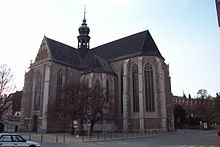| Revision as of 15:20, 10 August 2007 editLuca Borghi (talk | contribs)Extended confirmed users1,099 edits added the "Mendel Museum" section← Previous edit | Revision as of 12:32, 12 August 2007 edit undoFredericus~enwiki (talk | contribs)150 edits + 2 imagesNext edit → | ||
| Line 1: | Line 1: | ||
| ⚫ | ] | ||
| ]] | |||
| '''St Thomas's Abbey''' in ], despite communist repression, remained an operating ] monastery located in the present ]. The geneticist and ] ] was its most famous religious leader to date, and between 1856 and 1863 conducted his patient experiments on sweet pea plants in the monastery garden. His experiments brought forth two generalizations which later became known as ]. | '''St Thomas's Abbey''' in ], despite communist repression, remained an operating ] monastery located in the present ]. The geneticist and ] ] was its most famous religious leader to date, and between 1856 and 1863 conducted his patient experiments on sweet pea plants in the monastery garden. His experiments brought forth two generalizations which later became known as ]. | ||
| Line 11: | Line 13: | ||
| ==See also== | ==See also== | ||
| ⚫ | ] | ||
| * ] | * ] | ||
| * ] | * ] | ||
Revision as of 12:32, 12 August 2007



St Thomas's Abbey in Brno, despite communist repression, remained an operating Augustinian monastery located in the present Czech Republic. The geneticist and Abbot Gregor Mendel was its most famous religious leader to date, and between 1856 and 1863 conducted his patient experiments on sweet pea plants in the monastery garden. His experiments brought forth two generalizations which later became known as Mendel's Laws of Inheritance.
The Abbey is unique amongst modern Augustinian foundations because it is not called a priory, and indeed has an abbot whereas all other existing Augustinian friaries are led by a prior.
The Augustinians arrived in Brünn in 1346, and John Henry of Luxemburg (Jan Jindřich Lucemburský), Margrave of Moravia, began the construction of their original cloister in 1352. In 1653, the Order moved into the Abbey of St. Thomas at today's Moravian Palace. At that time the Brno noblewoman Sybil Polyxen Františka established a musical foundation for the monastery , with paid musical scholars. This was the early beginning of a long and siginificant musical tradition at the Brno monastery.
Czech composer Pavel Křížkovský also took monastic vows at Brno, teaching liturgical music from 1848 until 1872, and from 1865 he formed an ongoing musical collaboration with the young (lay) composer Leoš Janáček who had come from his home in Hukvaldy and begun as a choirboy at the monastery.
Mendel Museum
The Augustinian Abbey now hosts a Museum ] dedicated to the founder of Genetics. Visits to the Museum include a walk in the garden in which Mendel carried out his famous experiments.
See also
- List of Austrian scientists
- Mendelian inheritance
- Mendel University of Agriculture and Forestry Brno (named after Mendel since 1994)
Sources and external links
- Order of St Augustine, International Homepage
- Catholic Encyclopaedia - Hermits of St. Augustine
- Text of the Rule of St. Augustine
- Augustinian Abbey of St. Thomas at Brno
- Mendel Museum in Brno]
This article about a church building or other Christian place of worship is a stub. You can help Misplaced Pages by expanding it. |